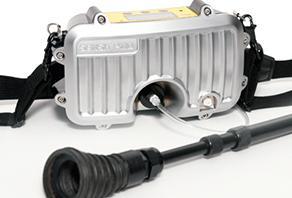
Once a year natural gas distribution companies are required to survey all of their pipelines for leaks. This is normally done by an army of employees traversing the distribution network on foot, holding a wand that continuously samples the air. The devices typically used for this chore operate on the principle of “flame ionization” - the sample is incinerated and the combustion product is analyzed. Those devices require the frequent swapping of canisters of hydrogen and will sometimes, confusingly, detect the presence of any hydrocarbon not just methane - the primary component of natural gas.
We worked very closely with a major manufacturer of gas detection instruments, and a researcher who had developed a new gas sensor technology, to create a portable methane detector (PMD). The sensor technology of the PMD works on a completely original principle - it shines infrared light through a continuous air sample and analyzes the light after passing through the sample. Because methane absorbs infrared light in a very specific and detectable way, the PMD only measures methane and thus ignores leaks from sources other than natural gas. We were responsible for industrial design and mechanical/electrical/systems engineering of the PMD. Our main goal was to create an ergonomic instrument with a low-cost and easy-to-manufacture sensor design. Other design challenges included temperature control within 0.10°C and TEC (thermoelectric cooling) for a stable -10°C sensor temperature. The rugged PMD is composed of a die-cast aluminum front face, injection molded ABS rear housing, adjustable straps for wearing and carrying the device, and a handheld wand for collecting air samples. The aluminum front face provides a rigid structure for assembling the PMD optics and also acts as a heat sink for precisely controlling temperatures inside the enclosure. The housing contains a halogen light source, a machined aluminum gas chamber housing a series of mirrors and sensors, a battery, and three custom-designed circuit boards. Electronics were designed within a 5000 V bias and the input is quantified using 24-bit low noise ADC (analog digital converter). In addition, the PMD was designed to provide for future expansion features such as Bluetooth connectivity for wireless data transfer, GPS, and SD card slot for data logging. We also helped to productize the device through our manufacturing liaison and testing services, and we contributed to the software development at the integration and optimization level.